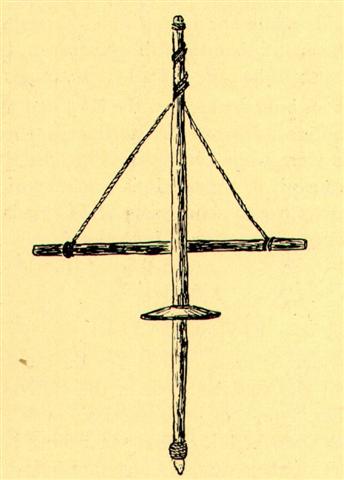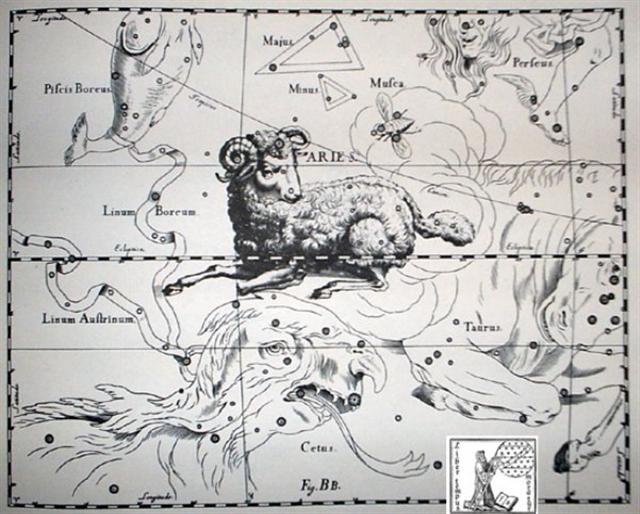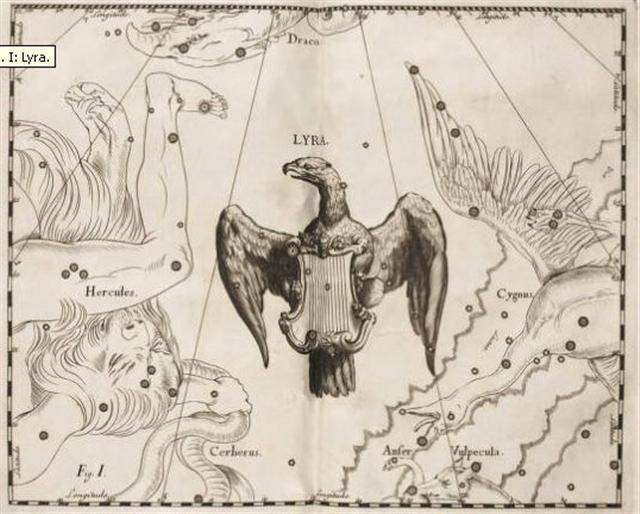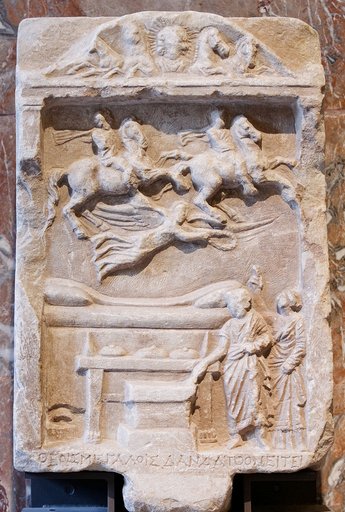396. The polar region was
outside the rising and setting phenomena of the stars closer to
the equator - something which unavoidably would have been
noticed by people accustomed to the view of the Chinese mill. Therefore
the place of Thuban should not be perceived as located at the other side of
the sky compared to Hamal, and I should rearrange
all the stars at the pole (both those in the north and those in the
south) to be instead together with their corresponding exit and entrance stars:

|
1-28
(393) |
1-29
(314 + 80) |
1-30 |
1-31
(396) |
|
FEBR 12 (408 = 360 + 48) |
13
(*329 = 409 - 80) |
14
(45 = 109 - 64) |
15
(☼327
= 411 - 84) |
 |
 |
 |
 |
|
Cb1-1 |
Cb1-2 |
Cb1-3 |
Cb1-4 (396 = 475 -
79) |
|
E tupu
ki roto
o te hau tea |
ki te henua - te maro |
|
Al Sharatain-1 /
Ashvini-1 /
Bond-16 (Dog) /
Mahrū-sha-rishu-ku-1 (Front of the Head of Ku)
SEGIN = ε Cassiopeia,
MESARTHIM = γ Arietis,
ψ Phoenicis (27.2),
SHERATAN (Pair of Signs) = β Arietis,
φ Phoenicis (27.4)
*351
= *27.4 - *41.4
POLARIS
(26.6 = 54 - 27.4) |
ι
Arietis (28.0), λ Arietis (28.2), υ Ceti (28.8) |
ALRISHA (The Knot) = α Piscium,
χ Phoenicis (29.2),
ALAMAK (Caracal) = γ Andromedae
(29.7) |
Arku-sha-rishu-ku-2 (Back of the Head of Ku)
2h (30.4)
κ
Arietis (30.3),
HAMAL (Sheep) = α Arietis
(30.5)
ALKES (α
Crateris)
THUBAN
(212 = 30 + 182) |
|
54 + 182 = 236 = 8 *
29˝ = 2 * 27 + 2 * 91 = 2 * 118 |
|
April 17 (107 = 472) |
18 |
19
(6 * 79 = 474) |
20
(290 + 185) |
|
'March 21 (107 - 27) |
22 |
23 |
24 (☼364
= 448 - 84) |
|
"March 7 |
8
(432 = 3 * 144) |
9 |
10
(*354 = 3 * 118) |
 |
The right ascension line at
Thuban was very far way from that of Polaris but they were
anyhow quite close together up at the pole and therefore
they ought to be quite close together also in the minds
of the readers of the rongorongo texts as well as the creators
of these texts.
.jpg)
Similarly should Vega be connected with a
place adjacent to some significant star
closer to the equator, but its supreme dominance over
all the following pole stars could also be
expressed in the basic structure itself - defining where
the north pole anciently had been and where it would return:
|
... Men's spirits were
thought to dwell in the
Milky Way between
incarnations. This
conception has been
handed down as an Orphic
and Pythagorean
tradition fitting into
the frame of the
migration of the soul.
Macrobius, who has
provided the broadest
report on the matter,
has it that souls ascend
by way of Capricorn, and
then, in order to be
reborn, descend again
through the 'Gate of
Cancer'. Macrobius talks
of signs; the
constellations rising at
the solstices in his
time (and still in ours)
were Gemini and
Sagittarius: the 'Gate
of Cancer' means Gemini
... |
|
SAGITTARIUS: |
|
20 |
Purva Ashadha |
δ and ε Sagittarii |
Elephant tusk, fan,
winnowing basket |
Dec 24 (358) |
|
first of the
ashādhā (the
invincible one, the name
of a constellation) |
Kaus |
|
LYRA: |
|
22 |
Abhijit |
α, ε, and ζ Lyrae |
- |
Dec 27 (361) |
|
victorious |
VEGA |
|
SAGITTARIUS: |
|
21 |
Uttara Ashadha
|
ζ and σ Sagittarii |
Elephant tusk, small bed |
Jan 3 (368) |
|
second
of the ashādhā |
Nunki |
|
AQUILA: |
|
23 |
Sravana
|
α, β, and γ Aquilae |
Ear or Three Footprints |
Jan 15 (380) |
|
- |
Altair |
|
DELPHINUS: |
|
24 |
Dhanishta |
α, β, γ, and δ Delphini |
Drum or flute |
Jan 29 (394) |
|
most famous (or
swiftest) |
Dolphin |
|
10-7 (*200) |
10-8 |
10-9 |
10-10
(☼199) |
10-11 (364 -
80) |
|
OCT 22 (295) |
23 (*216) |
24 |
25 (☼214) |
26 |
 |
 |
 |
 |
 |
|
Ga8-12 |
Ga8-13 (216) |
Ga8-14 |
Ga8-15 |
Ga8-16 |
|
KAUS BOREALIS = λ Sagittarii
(279.3) |
ν Pavonis (280.4), κ Cor. Austr. (280.9)
*239 = *280.4 - *41.4 |
Abhijit-22 (Victorious)
θ
Cor. Austr.
(281.0),
VEGA = α Lyrae
(281.8) |
no star listed (282)
VEGA
(282 = 6 * 79 - 192) |
ζ Pavonis (283.4), λ Cor. Austr.
(283.6),
DOUBLE DOUBLE = ε Lyrae
(283.7), ζ Lyrae (283.8)
*242 = *283.4 - *41.4 |
 |
|
Dec 25 |
26 (360) |
27 |
28 |
29 |
|
SOLSTICE |
°Dec 22 (356) |
23 (*277) |
CHRISTMAS EVE |
25 |
|
'Nov 28 |
29 |
30 (☼250) |
'Dec 1 |
2 (336 = 4 * 84) |
|
"Nov 14 |
15 |
16 (☼236) |
17 (321) |
18 |
Possibly the peculiar curved top
of nuku presented at Ga7-21 - and
then recurring time and again all the way up to
Vega - was alluding to the Phrygian cap
(helmet) worn by the warriors of Alexander,
who always was victorious (abhijit).
 |
 |
|
nuku |
hoea |
 |
 |
 |
|
 |
 |
|
 |
 |
 |
|
Ga7-14 |
Ga7-15 (184) |
Ga7-16 |
Ga7-17 |
Ga7-18 |
Ga7-19 |
Ga7-20 |
Ga7-21 |
|
... The practice of turning down
the fingers, contrary to our
practice, deserves notice, as
perhaps explaining why sometimes
savages are reported to be
unable to count above four. The
European holds up one finger,
which he counts, the native
counts those that are down and
says 'four'. Two fingers held
up, the native counting those
that are down, calls 'three';
and so on until the white man,
holding up five fingers, gives
the native none turned down to
count. The native is nunplussed,
and the enquirer reports that
savages can not count above four
...
...
The state of the
tree loomed large in their
thoughts, because it came about
at the same time the head of One
Hunaphu was put in the fork. The
Xibalbans said among themselves:
'No one is to pick the fruit,
nor is anyone to go beneath the
tree', they said. They
restricted themselves, all of
Xibalba held back. It isn't
clear which is the head of One
Hunaphu; now it's exactly the
same as the fruit of the tree.
Calabash came to be its name,
and much was said about it. A
maiden heard about it, and here
we shall tell of her arrival.
And here is the account of a
maiden, the daughter of a lord
named Blood Gatherer. And this
is when a maiden heard of it,
the daughter of a lord. Blood
Gatherer is the name of her
father, and Blood Moon is the
name of the maiden. And when he
heard the account of the fruit
of the tree, her father retold
it. And she was amazed at the
account: I'm not acquainted with
that tree they talk about. It's
fruit is truly sweet! they say,
I hear, she said. Next, she went
all alone and arrived where the
tree stood. It stood at the
Place of Ball Game Sacrifice.
What? Well! What's the fruit of
this tree? Shouldn't this tree
bear something sweet? They
shouldn't die, they shouldn't be
wasted. Should I pick one? said
the maiden. And then the bone
spoke; it was there in the fork
of the tree: Why do you want a
mere bone, a round thing in the
branches of a tree? said the
head of One Hunaphu when it
spoke to the maiden. You don't
want it, she was told. I do want
it, said the maiden. Very well.
Stretch out your right hand
here, so I can see it, said the
bone. Yes, said the maiden. She
stretched out her right hand, up
there in front of the bone. And
then the bone spit out its
saliva, which landed squarely in
the hand of the maiden. And then
she looked in her hand, she
inspected it right away, but the
bone's saliva wasn't in her
hand. It is just a sign I have
given you, my saliva, my
spittle. This, my head, has
nothing on it - just bone,
nothing of meat. It's just the
same with the head of a great
lord: it's just the flesh that
makes his face look good. And
when he dies, people get
frightened by his bones. After
that, his son is like his
saliva, his spittle, in his
being, whether it be the son of
a lord or the son of a
craftsman, an orator. The father
does not disappear, but goes on
being fulfilled. Neither dimmed
nor destroyed is the face of a
lord, a warrior, craftsman, an
orator. Rather, he will leave
his daughters and sons. So it is
that I have done likewise
through you. Now go up there on
the face of the earth; you will
not die. Keep the word. So be
it, said the head of One and
Seven Hunaphu - they were of one
mind when they did it ... |

|



.jpg)











